#francis davis millet
Explore tagged Tumblr posts
Text
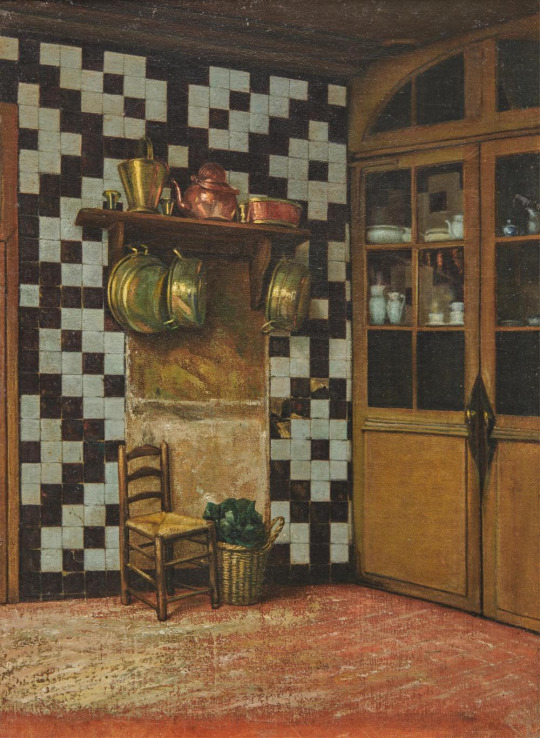
Francis Davis Millet (American, 1846-1912) • Flemish Kitchen • Unknown date
#art#painting#fine art#art history#francis davis millet#american artist#oil painting#19th century american art#artwork#paintings of interiors#domestic interiors#kitchen interior#the painted room art blog#art blogs on tumblr#academic classical art
54 notes
·
View notes
Text
titanic historians be like “although it was heavily theorized, it’s impossible to know for certain whether Major Butt, a lifelong bachelor who lived in Foggy Bottom alone with his male best friend, was actually gay” is it? is it really?
2 notes
·
View notes
Text

The Granddaughter by Francis Davis Millet
3 notes
·
View notes
Text

Oh, look. The exact same painting behind Bertie this time, in a different pub in Hot Off the Presses.
Two of my long-term obsessions have just collided in an odd way.
I was watching "Wooster With a Wife" for the first time in about a decade and when I got to this scene, I gasped.

Because that little painting behind Jeeves looks like nothing much, but it used to be famous. It's called "Between Two Fires," and it was painted by the American master, Francis Davis Millet, in 1892.

It depicts a 17th-Century man sitting between two standing women, beneath a sprig of mistletoe. The piece itself was extremely popular in its time. It was often hung in houses, it was printed onto cigarette cases and biscuit tins. That's probably how it came to be hanging there on the wall of a pub. Somebody hung it there in 1900 and never took it down.
The thing that is particularly interesting to me, personally, about this painting is the artist who painted it. Frank Millet, born in Massachusetts in 1843, was once one of the most famous American artists in the world. He did murals in great cities across Europe and America, painted a portrait of his friend Mark Twain, was a personal friend of President William Howard Taft and John Singer Sargent. He was married and had children, but he was also known for having rather public relationships with other men, most notably the writer Charles Warren Stoddard. Their love letters are still in existence and some have been published in a biography of Stoddard.
Francis Davis Millet:
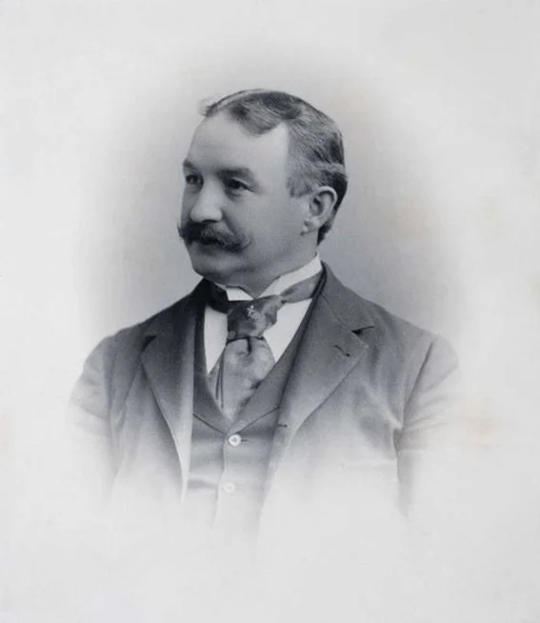
These days, the most famous thing about him is that he died on the Titanic, and as such he is the only confirmed queer victim of the Titanic sinking (obviously there must have been many others, but he's the only one with existing documentation that proves it). He happened to be traveling with a close friend whom he lived with, one Major Archibald Butt, who is often theorized to have been his partner at the time. We don't know much about their lives together, but we do know (from a letter Butt once wrote to his sister-in-law) that Millet wall-papered the inside of their house while Butt was away on a business trip. The wallpaper he chose was roses – so many roses, Butt said that he felt he was suffocating beneath a giant pile of them. It's rare to get any insight at all into the lives of men who may have been partners at that time, and I always rather loved this particular little story.
Major Archibald Butt:

Both men died in the sinking and they share a joint memorial fountain in Washington, DC. It's just behind the White House and was erected by their friends, who remembered them as being devoted to each other. Here's a little bit of information about the fountain from the National Park Service:
89 notes
·
View notes
Text
Mother's Day around the world

Mother's Day card from Fantabuloustef Zazzle Collection.
When it comes to creating art for online Print-on-demand platforms, one of the keys to success lies in understanding the trends and timing of the year. Knowing when certain seasonal events, holidays, or special occasions are coming up can help you create art that will be popular at just the right time. There are certain important dates throughout the year that define what people are looking for and when they’re looking for it.
A few weeks ago, I began the exciting task of preparing collections of cards for Mother's Day. As I delved deeper into the subject, I discovered that Mother's Day celebration dates may vary across countries, and quickly realized I was running behind in preparig my creations for some of them! So, I decided to dig a bit deeper into this topic, and to share my findings in this post.
Brief History of Mother's Day
The observance of modern Mother's day, has its origins deeply rooted in history. This celebration can be traced back to various ancient cults and festivities. Initially, it was primarily focused on celebrating motherhood as the act of giving birth. However, with time, it evolved to encompass the aspect of children's care as well.
The earliest recorded evidence of any type of mother-centric holiday dates can be found in Egypt pharaonic tradition. (starting around 3000 BC)
For thousands of years, the Ancient Egyptians celebrated a yearly festival to honor the beloved goddess Isis, who was known for her embodiment of the perfect mother and wife. Isis was married to her brother Osiris, who was tragically killed by their jealous brother Set. Undeterred, Isis collected his scattered body parts and used them to conceive their son Horus. Horus later avenged his father's death by killing Set and became the first ruler of Egypt, thus making Isis the mother of all pharaohs and a symbol of motherhood.
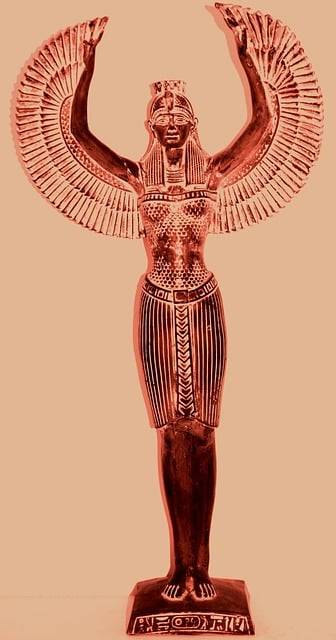
Isis statue - Picture by Liliane Caliste from Pixabay
Ancient Greeks used to organize a yearly festival during spring known as "thesmophoria" which was dedicated to Rhea, the mother goddess figure (From 1100 BC). This festival involved rituals such as offerings made by daughters for their deceased mothers who had passed away during childbirth or sicknesses related to childbearing process.
It also included feasting together with family members while exchanging gifts among each other - practices still observed today on Mother’s day celebrations worldwide!

Painting : Thesmophoria' by Francis Davis Millet, 1894-1897 - Brigham Young University Museum of Art
The phrygians also held a festival for Cybele, the Great Mother of the gods. It was celebrated in Anatolia (modern-day Turkey), in the spring and included processions, music, dancing, and sacrifices. This festival was an important part of the culture and religion of the people of Anatolia and was celebrated for centuries. It was a celebration of the power of motherhood and fertility and was a way of honoring the divine feminine. The festival also celebrated the bond between a mother and her children.
The Roman Empire had their own version of "thesmophoria" known as “Matronalia” which honored Juno Lucina - the patroness deity associated with fertility and childbirth. Traditionally, the festival was celebrated on the 1st of March and was marked by feasting, offering of prayers, and giving of presents. In addition to honoring Juno, the Matronalia Roman Festival was also a time of celebration for all women, as it was believed to bring them good luck and fertility. (7th century BC)
During the Middle Ages, a tradition began to gain popularity in medieval England, which granted those who had moved away from their home parishes the opportunity to visit the place of their birth and their mothers on Laetare Sunday, the fourth Sunday of Lent. This custom soon became known as Mothering Sunday in Britain, and with the passage of time, it evolved into what we now know as Mother's Day.
In India, the festival of Durga Puja, (Durga : the mother Goddess), is also considered as one of the roots of the modern Mother's day celebrations. It is believed to have originated in the 16th century when King Krishnadeva Raya of the Vijayanagara Empire is said to have organized the first Durga Puja.
Since then, it has become an important part of Hindu culture and is celebrated with great enthusiasm and devotion.
The reason for commemorating this festival is not limited to expressing reverence to the divine, but also to acknowledge motherhood and its exceptional virtues like boundless love, tenderness, and nurturing. These endearing qualities have been bestowed upon their children by mothers for ages, without anticipating any reward except the contentment and joy of them. According to Hindu mythology, Maa Kali (an incarnation of Maa durga) is believed to have created the universe out of her sheer compassion towards her offspring. Thus, she represents the epitome of selfless love, which is both affectionate and tender.

Durga Puja - Photo by Souvik laha
Modern Mother's Day adoption
The international Mother's Day originated from the United States and takes place the 2nd Sunday of May.
Anna Jarvis of Philadelphia initiated the movement for a dedicated holiday to honour mothers in the United States after her personal loss in 1906. Within five years, nearly every state observed the day and in 1914 President Woodrow Wilson finally declared the second Sunday of May as "Mother's Day" throughout America.

Portrait of Anna Jarvis
Progressively, the celebration has evolved, to encompass additional individuals such as grandmothers and aunts who plays mothering roles.
The day initially meant for showing respect gradually transformed into a day of exchanging greeting cards and presents. Jarvis, the founder of the holiday, spent her final years protesting against its commercialization and striving to eliminate it altogether.
Mother's day contemporary celebrations around the world.
The second Sunday of May, which was first introduced by the United States, has now evolved into the globally celebrated "International Mother's Day." Many countries have officially adopted this modern date for honoring mothers, including the United States, India, Canada, Japan, Australia, South Africa, and many more.
Numerous countries worldwide share a similar set of customs and routines to commemorate Mother's day. These include sending cards, presenting gifts and flowers, and taking their mothers out for a special meal. Moreover, it's prevalent for kids to create their own handcrafted cards or gifts to express their affection, gratitude and love towards their moms.
In the following section, I have delved into the unique and distinct aspects of celebrations across various countries, including the dates he dates opted by those who do not follow the international date.
Specificities for a few countries that celebrate the international mother's day
United States
In United States, a notable fact is that it's usual to offer lilac or roses but also large hydrangeas to symbolize gratitude.
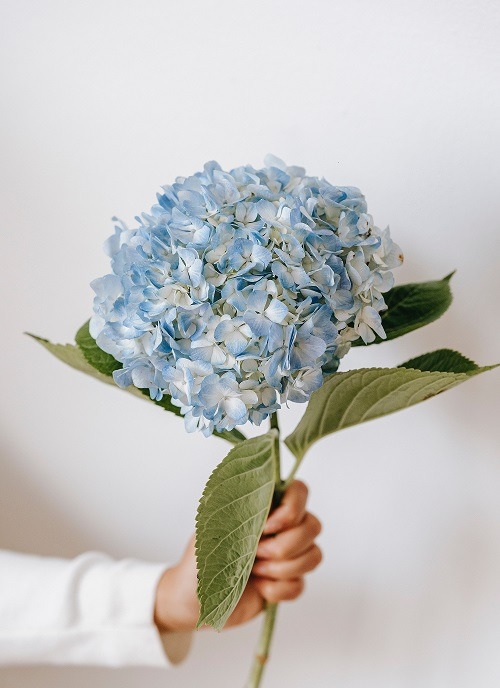
Hydrangea - Photo by Teona Swift
Canada
In Canada, it is a day to honor mothers, grandmothers, and mother figures. In addition to the customs adopted worldwide, some counties will also celebrate with a Mother’s Day mass or special church service.
Every year, cities across Canada host the annual Mother's Day Walk, a fundraising event that supports local charities and organizations which help women and children. This action is a great opportunity for participants to pay tribute to their mother, grandmother, or any other special woman in their life. Typically, the walk covers a distance of 3-4 km and is filled with fun activities and entertainment. Sometimes, there's a memorial section where participants can honor their loved ones by leaving flowers or mementos. This event is an excellent way to celebrate motherood while also contributing to a worthwhile cause.
India
In India, Mother's Day is celebrated with great enthusiasm and joy. The traditional Indian way to honor mothers is to give them gifts and express their gratitude. On this day, families come together to celebrate the important role mothers play in our lives. People may exchange gifts like traditional Indian sweets, flowers, jewelry, and fabric.
In many parts of India, children may even put a vermilion mark on their mother's forehead as a sign of respect and love.
Additionally, in Hindu households, Mother's Day is often celebrated with great religious reverence. People come together to perform puja to the divine mother, Durga, to ask for her blessings on their mothers and families. It is a special day to honor the powerful energy of the mother of the universe and to show gratitude for the unconditional love she provides.
Japan
In Japan, the celebration is gaining popularity, since it corresponds to the traditional principles of respect for parents and the elderly. It is now known as Haha no Hi (母の日). The celebration was introduced to in the early 1920s, and it has become a popular holiday ever since.
Along with the general festivities, the day is also marked by visits to shrines and temples, where prayers are said for the health and happiness of mothers and other family members.
Japan's population is steadily declining. This can be explained in many ways, but the very low birth rate is often singled out. Japanese mothers are encouraged (at least by the Japanese government) to embrace their role as mothers more quickly and more intensely. For this reason, this national holiday offers a moment of welcome recognition to all these valiant women!
Australia
Mother's day tradition dates back to 1924 when Leichhardt Sydney resident Janet Heyden began visiting patients at Newinton State Home for Women. The hospital housed a number of mothers without families to care for them. To bring happiness into the lives of these abandoned mothers, Janet Heyden decided to present them with gifts with the help of the community. Another unique thing that sets Australian Mother's Day apart is the Chrysanthemum flower. This fall flower was chosen because its name in English contains the word mom.
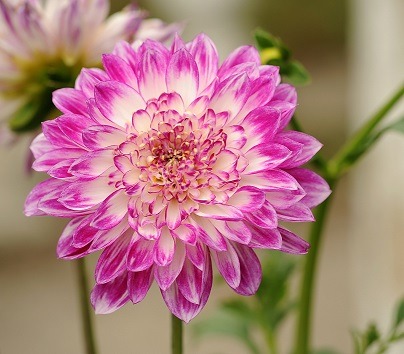
Chrysanthemum - Pixabay picture
A few countries that celebrate mothers on another day
United Kingdom
In UK, mother's day is the 4th Sunday of Lent and directly comes from the Mothering Sunday.
For this momentous occasion, in addition to the other traditional festivities, it is customary for girls to bake a special cake known as the mothering cake or "simnel cake", as a special tribute. This cake is composed of dried fruit and adorned with 11 marzipan balls, symbolizing the 11 loyal apostles of Christ, excluding Judas. It may also be topped with sugar violets.
Mexico
In Mexico, Mother’s Day is celebrated the 10th of May with a lot of enthusiasm and joy. May 10 holds significance because it was traditionally considered as the "pay day" in Mexico, allowing people to splurge on their mother's gifts or take her out for an extravagant dinner. Additionally, the month of May in Mexico is dedicated to honoring the Virgin Mary, one of the most renowned mothers in history.
Even though Mother's Day in Mexico was only established a little over a century ago, motherhood have been honored from ancient times. Mexico has long been a place where powerful matriarchs take center stage. Pre-Columbian civilizations like the Mayans had a rich pantheon of goddesses, led by Ix Chel - representing fertility and motherhood that were celebrated and honored.
Mother's day celebration are very happy and include dancing, music, food, and special gifts.
On Dia de las Madres, flowers are a popular gift, but for many Mexican moms, the most valuable present is something that money can't buy. On the morning of Mother's Day, children come together to serenade mom with the traditional song "Las Mañanitas". The heartfelt lyrics express their love and appreciation for their mother, and the sound of their voices, sometimes accompanied by a mariachi band, is the most meaningful Mother's Day experience.
youtube
Lyrics translation ( some variants exist):
These are the little mornings In which King David used to sing And on the day of your Saint So we sing it for you. Wake up, my dear, wake up, Look, it's already dawning, The little birds already are singing, The moon has gone away. How beautiful is the morning In which I'm coming to greet you, We all are coming with joy And are happy to congratulate you. The day that you were born All flowers were born too, In the baptismal The nightingales are singing. Day is already breaking And the light the day is making Gets us up in the morning, Look, it's already dawning.
I'd love to be a little sun To enter your window To say "good morning" to you While you're lying in your bed.
Four doves flew By every city Today because it's your saint's day, We wish you happiness.
With jasmine and flowers I will decorate this day, And today for being your saint day We have come to dance for you.
Thaïland
in Thailand, Mother's Day is celebrated on August 12th, which is the birthday of Queen Sirikit, the Thai mother figure.
On this day, making an offering to monks is an important part of the traditional Mother's Day ceremony.
It is also customary to give the mother of the family a jasmine garland, which is a traditional Thai symbol of respect.
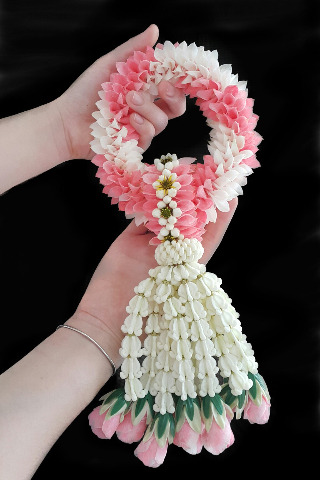
Traditional Thaï Jasmine Garland
Egypt
In Egypt, Mother's day is celebrated the 21st of March, first day of Spring. Back in 1956, a journalist and poet named Mustafa Amin initiated a year-long awareness campaign that led to setting aside a special date. He first proposed the idea in a poem he wrote in 1934, calling for a day to celebrate the contributions of mothers in Egypt. His poem argued that mothers deserved greater recognition for the hard work and sacrifices they made for their families and society.
Originally, the holiday was celebrated in August and was known as the "Festival of the Mothers of Egypt," or "Yom el-Omara El-Misreyeen" in Arabic. Over the years, the date of the celebration was changed to the 21st of March.
This special day is celebrated by treating mothers like queens, allowing them to rest and relax while others take over their daily tasks.
France
Mother's Day is observed in France on the final Sunday of May, but if it coincides with the Pentecost festival, then it is rescheduled for the initial Sunday of June. This will be the situation in 2023.
The tradition of celebrating Mother's Day has a heartwarming past. The original celebration dates back to the Napoleonic era, when Emperor Napoleon I established a day dedicated to honoring the mothers of large families. After World War I, an official Mother's Day was held in Lyon to pay tribute to the widows who lost their husbands during the war. The French government officially recognized Mother's Day in 1929, and in 1941, the Vichy Regime chose the last Sunday of May as the official date. Finally, after nine years, a law was passed that stated, "Every year, the French Republic pays an official tribute to Mothers during a special day dedicated to celebrating Mother's Day."
Conclusion
Mother's Day is a remarkable day of appreciation and recognition for mothers all around the world. It's a day that has been celebrated for centuries, tracing its origins back to as far as 5,000 years ago.
Over time, this celebration has evolved from being an ancient ritual to becoming a modern tradition that honors not only individual mothers but also all women serving in maternal roles across different cultures and countries.
In many countries it's celebrated on the second Sunday of May, that is now considered as the international Mother's day.
The ways of celebrating this special occasion vary according to cultural traditions, but one thing remains the same: Mothers are celebrated for their unconditional love and support.
In the introduction of this blog post, I initially intended to write about my beloved mother. However, I ultimately decided against it, as it would have monopolized the entire post. In my heart, she holds a special place as the most loving, devoted, and gentle person I have ever encountered. I am unsure whether this sentiment is unique to our bond or if it resonates with every child and mother across the globe.
Mother's Day makes us think of our moms and how much we love them, but let's not forget to remind them of our love and gratitude regularly! No matter where you live, if you are lucky enough to still have your mom around, show her your appreciation every single day!
If you have any unique customs or traditions in your country that you'd like to share, I'd love to hear about them in the comments section! I'm sure there's a lot I haven't covered in this blog post, so your input would be greatly appreciated.
Bibliography
Memorializing Motherhood: Anna Jarvis and the Struggle for the Control of Mother’s Day by Katharine Lane Antolini
History of mother's day: From ancient Egypt to modern times American University in Cairo
Mama Lisa's World International music & culture
Mother's day traditions around the world - Scholastic
Mother's day in India - Bhupinder Singh
Mother's day in Australia - Lepetitjournal Perth
Mother's day in Japan - furansujapon.com
Mother's day in Mexico - pinandtravel
Mother's day in Thaïland - Taste of Thaïland
Simnel Cake Recipe - BBC
Illustrations
Isis statue - Picture by Liliane Caliste from Pixabay
Painting - Thesmophoria' by Francis Davis Millet, 1894-1897 - Brigham Young University Museum of Art : Public Domain
Portrait of Anna Jarvis
Hydrangea - Photo by Teona Swift
Chrysanthemum - Pixabay picture
Traditional Thaï Jasmine Garland - Pxfuel
Discover my collection of cards and gifts for Mother's Day, most of them are downloadable if you're late !
#Youtube#mother’s day#mother's day gifts#mother's day customs#mother's day traditions#original art#mother's day card#fantabuloustef#artists on tumblr
3 notes
·
View notes
Text

Reading the Story of Oenone Francis Davis Millet 1883
3 notes
·
View notes
Text
Simple Art Posters & Canvas Prints

100+ Famous Artists of All Time
#francis davis millet#Sam Francis#Victor Vasarely#bored of directors#Cindy Sherman#Damien Hirst#Paul Cezanne#Joseph-Nicolas Robert-Fleury#Leon Cogniet#Leonard Bramer#Lionel Noel Royer#Louis Gallait#Nicolaes Cornelisz Moeyaert#Noel Halle#Paul Delaroche#Pierre Subleyras#Pieter Lastman#Than Mor
70 notes
·
View notes
Text

Today Sept 10, our Fun Friends in #AncientGreece would have been getting down with day 1 of 5-day #Thesmophoria (#Demeter’s #women’s festival in ancient Greece)
( https://www.thoughtco.com/thesmophoria-111764 )
#Painting: ‘Thesmophoria’ by Francis Davis Millet,1894-1897
0 notes
Text

Francis Davis Millet (American, 1848-1912) • Room Interior with Winding Staircase • Between 1846 and 1912 • Smithsonian Museum of American Art
Interesting fact: Francis Millet was among the passengers who perished on the Titanic in 1912.
#art#fine art#painting#art history#paintings of interiors#francis davis millet#paintings of domestic interiors#american artist#american painter#oil painting#19th-early 20th century american art#the painted room art blog#art blogs on tumblr#art blogs
87 notes
·
View notes
Link
0 notes
Text
3/20 HW: Museum Extra Credit
I went to the Met :)
4 things I liked:




Top Left: Louis Lang, Art Students, ca. 1871 -> I like it because the palette transitions from dark colors, to lighter colors, as if you were entering the area.
Top Right: William Merritt Chase, Alice Gerson in Prospect Park, 1886 -> I like it because of the use of muted colors, makes it more realistic. I also like the reflection of the boat on the water. :)
Bottom Left: Nicolás Enríquez, The Apparition of the Virgin of El Pilar to Saint James, 1773 -> I like the bright colors, the use of bright colors and smooth brushstrokes makes the painting feel dreamy. :)
Bottom Right: Helena de Kay, Water Lilies, ca. 1870-77 -> I like flowers :)
4 things I "disliked" (I don't dislike them, I just prefer the 4 above):




Top Left: Winslow Homer, The Studio, 1867 -> I "dislike" this because I feel a disconnect because of the placement of the subjects on the picture plane. There is a large amount of space between the subjects and the viewer.
Top Right: John La Farge, Portrait of the Painter, 1859 -> I "dislike" this because the use of bright colors for the background makes it pop more than the actual subject. But I do like the juxaposition.
Bottom Left: Thomas Wilmer Dewing, La Peche, 1901-04 -> I "dislike" this for a similar reason, the background and the subjects appear to blend together where its hard to tell what the actual focus point is.
Bottom Right: Franz Anton Maulbertsch, The Glorification of the Royal Hungarian Saints, ca. 1772-73 -> didn't stand out to me :0
Artwork that uses color to evoke mood:

Pierre Jacques Volaire, The Eruption of Vesuvius, a View of Naples Beyond, ca. 1776 -> The artist uses warm and dark colors in order to evoke fear. The majority of the painting is covered in dark, muted colors, all but the volcano, where its lava is bright orange. This being one of the only light sources evokes fear.
Painting with interesting use of warm & cool colors:

Francis Davis Millet, A Cosey Corner, 1884 -> The differing use of warm and cool colors in this painting is very interesting. The cool colors are prominently present in the surroundings of the subject. On the other hand, warm colors are most prominent in the subject in the center. This distinct use of warm and cool colors makes the subject stand out as the focal point.
1 note
·
View note
Text

The Widow by Francis Davis Millet / "ivy" by Taylor Swift
#the widow#francis davis millet#american realism#academicism#ivy#taylor swift#evermore#realism#art history#tswiftart#i just sit here and wait grieving for the living :))))
317 notes
·
View notes


